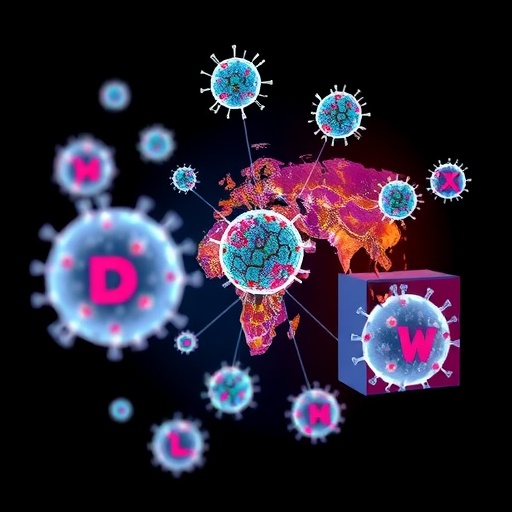Recent advancements in cancer research have illuminated the essential role of tumor microenvironment components in promoting cancer progression. Among these components, syndecan-2, a member of the syndecan family of proteoglycans, has emerged as a key player in various malignancies. Recent investigations have highlighted the alarming link between syndecan-2 overexpression and the aggressive nature of papillary thyroid cancer (PTC). Researchers Liu, R., Lv, X., and Wang, H. have provided significant insights into the mechanisms by which syndecan-2 mediates tumor biology, thereby indicating that targeting this proteoglycan may present a novel therapeutic strategy against PTC.
The fundamental premise of their research centers on the increasingly recognized role of syndecan-2 in modulating cancer cell behavior, especially traits associated with cancer invasiveness and de-differentiation. In their study, which appears in BMC Endocrine Disorders, the authors convincingly demonstrate that elevated levels of syndecan-2 correlate with heightened invasive capabilities in papillary thyroid cancer cells. This correlation raises critical questions about the role of extracellular matrix components in tumor biology, suggesting that changes in proteoglycan expression may be a pivotal determinant of cancer progression, specifically in the context of PTC.
Employing rigorous experimental approaches, the researchers utilized both in vitro and in vivo models to elucidate the functional consequences of syndecan-2 expression. In vitro assays revealed that PTC cells expressing high levels of syndecan-2 demonstrated significantly enhanced migration and invasion compared to control cells. These findings underscore the importance of syndecan-2 in facilitating the malignant properties characteristic of PTC, highlighting that tumor cells adapt their behavior to exploit the microenvironment for productive invasion.
To investigate whether targeting syndecan-2 could influence PTC malignancy, Liu and colleagues employed small interfering RNA (siRNA) techniques to reduce syndecan-2 expression levels in PTC cell lines. The results were striking; decreased expression of syndecan-2 not only reduced migratory and invasive functions but also reinstated a more differentiated phenotype in the cancer cells. This indicates that syndecan-2 is not merely a marker of aggression but actively contributes to the loss of differentiation associated with tumor progression, presenting a dual mechanism through which cancer aggressiveness and de-differentiation operate.
Moreover, the authors explored potential molecular pathways involved in syndecan-2-mediated processes. They identified critical signaling cascades such as the ERK and Akt pathways, which are known to regulate cell proliferation, survival, and motility. Inhibition of these pathways in syndecan-2 knockdown PTC cells led to a marked decrease in invasive behavior, suggesting that syndecan-2 acts as a facilitator of these oncogenic signals. Understanding these pathways is crucial for devising potential therapeutic interventions aimed at disrupting the syndecan-2 signaling axis.
Interestingly, the study also discusses the implications of targeting syndecan-2 in a clinical context. Current therapeutic options for PTC remain limited, particularly for patients diagnosed at advanced stages of the disease. With the identified role of syndecan-2 in promoting invasiveness and de-differentiation, it becomes increasingly apparent that therapeutic strategies aimed at inhibiting this proteoglycan could significantly improve patient outcomes by hindering metastatic spread. Thus, a syndecan-2-targeted approach may serve as a promising avenue for developing novel anti-cancer therapies.
Furthermore, the temporal aspect of syndecan-2 expression raises vital questions regarding early detection and intervention strategies. Elevated syndecan-2 levels may serve as a precursor indicator or biomarker for aggressive PTC, allowing for earlier identification of patients who may benefit from intensive monitoring and proactive treatment approaches. The potential to identify patients at risk of aggressive disease has profound implications for personalized medicine, signaling a pivotal shift toward tailored, patient-specific therapeutic modalities.
As the researchers emphasize, while the promising results associated with targeting syndecan-2 are significant, further investigations are warranted to fully understand its roles in PTC and potentially other malignancies. Future studies could explore the implications of syndecan-2 knockdown in animal models to ascertain the genetic and epigenetic factors driving PTC progression. Moreover, elucidating the interactions between syndecan-2 and other microenvironmental elements may shed light on the complex cellular dialogues that propel tumor evolution.
In conclusion, the research spearheaded by Liu and colleagues brings forth compelling evidence that targeting syndecan-2 may represent a revolutionary strategy in combatting papillary thyroid cancer. It underlines a pressing need to expand our comprehension of tumor biology and the microenvironmental factors that dictate cancer behavior. As we look to the future of cancer therapy, the inhibition of proteoglycans like syndecan-2 may offer new hope for patients battling this formidable disease, paving the way for more effective treatment modalities that address the roots of cancer progression itself.
Despite the encouraging direction of this research, it is essential to exercise cautious optimism. Clinical application of targeting syndecan-2 will require comprehensive studies, including clinical trials that rigorously assess the safety and efficacy of such interventions. There remains a myriad of questions and potential variables to tackle in this endeavor, including the long-term sustainability of therapeutic effects and the adaptation of cancer cells to prevent treatment efficacy.
The exploration of syndecan-2 in papillary thyroid cancer signifies not just a potential breakthrough in addressing this specific malignancy, but it also emphasizes the broader significance of proteoglycans in cancer biology. As we develop a more nuanced understanding of how tumors interact with their microenvironment, the potential to design innovative therapies becomes increasingly apparent.
With these strides in mind, the study by Liu et al. holds promise not only for insights into papillary thyroid cancer but for cancer research holistically. By pinpointing such critical components of the tumor microenvironment, we inch closer to reimagining therapeutic strategies that are not only effective but also dynamic enough to overcome the ever-evolving nature of cancer.
Subject of Research: Targeting syndecan-2 in papillary thyroid cancer to inhibit invasiveness and de-differentiation.
Article Title: Targeting syndecan-2 inhibits papillary thyroid cancer invasiveness and de-differentiation.
Article References: Liu, R., Lv, X., Wang, H. et al. Targeting syndecan-2 inhibits papillary thyroid cancer invasiveness and de-differentiation. BMC Endocr Disord 25, 242 (2025). https://doi.org/10.1186/s12902-025-02055-3
Image Credits: AI Generated
DOI: 10.1186/s12902-025-02055-3
Keywords: syndecan-2, papillary thyroid cancer, invasiveness, de-differentiation, proteoglycans, cancer biology.
Tags: BMC Endocrine Disorders publicationcancer cell behavior modulationde-differentiation in thyroid cancerextracellular matrix and cancer progressioninvasive capabilities of cancer cellsnovel therapeutic strategies for PTCpapillary thyroid cancer researchproteoglycans in malignanciessyndecan-2 role in cancertargeting syndecan-2 for therapythyroid cancer invasiveness studytumor microenvironment components





